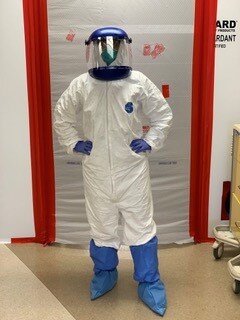Dr. Roneet Lev Addresses Barriers to Overdose Prevention in Health Care
From the time she was in eighth grade, Roneet Lev knew she wanted to be a doctor. Even as a child, she liked helping people and being of service. Although she didn’t have any family role models and her favorite high school biology teacher confided that she had been told she couldn’t become a doctor because she was a woman, Lev was undeterred. From an early age, the best way to motivate her was to say “no.”
Originally, she planned to become a pediatrician, but when she discovered the new specialty of emergency medicine, she was intrigued. This work synched best with her personality. After graduating from medical school, she did a residency in the first class of emergency medicine at the University of California, San Diego.
Thirty years later, she’s still energized by “life in the fishbowl,” the constant need to multitask by treating many patients at the same time and having every day be different. Being an emergency department (ED) physician is also perfect for someone who describes herself as lacking patience. Lev says, “I picked the right specialty and have no regrets. There is a common saying, ‘All the world is a stage and people in the emergency department have the front seat.’ I take the problems I see in the emergency department and try to make a difference in the community.”
“Many parts of the country have absolutely nowhere to go for treatment. There is no precedence in the medical world for requiring eight or 24 hours of education before prescribing a single medication. Can you imagine creating such a barrier to prescribing insulin or a new treatment for COVID-19?”
Lev, who is board certified in emergency and addiction medicine, uses data and personal experience to analyze what needs fixing and to “push, push, push” to do something about it.
She led a working group on safe prescribing to get the medical community to look at prescription rates for opioids. She said that originally physicians were misled and later given better data and guidelines that resulted in decreased overdoses from prescriptions and doctor shopping. But there is still more work to do because safe prescribing means coordinating multiple depressant medications that include opioids, benzodiazepines, sleep aids, stimulants as well as cannabis products. According to Lev, the medical community can take ownership of the supply chain of unintentional prescription drug overdoses and assist any person with a substance use disorder to obtain treatment. However, law enforcement is essential in decreasing the supply of illicit drugs. Deaths from fentanyl have doubled in the past year in San Diego as the drug is found in everything from methamphetamine, cocaine, heroin, and even marijuana and vaping products. The danger hit home for her recently when a family friend’s 18-year-old daughter died after coming in contact with a fake oxycodone pill that contained fentanyl.
Lev is advocating for fentanyl to be included in every urine drug screen. Currently there’s no FDA-approved panel of drug tests that includes fentanyl, she is leading a project to have all San Diego hospitals include fentanyl in their rapid drug test, and, she’s pushing for contract tracing. “If multiple patients come into the ED with serious diarrhea from something they ate at a restaurant, the health department goes out and investigates. A similar system should be developed for drug overdoses.”
For example, a John Doe was brought into the Scripps Mercy ED, where she works, with an overdose. She put him on a ventilator, stabilized him and then moved him to the ICU. When he tested positive for fentanyl, she asked, “Who else?” and got law enforcement to trace it back to a home where they found three other people who could have died. In this case, law enforcement was able to get to the source, identify John Doe and connect him to his family.
Her newest push is working hard to remove barriers, such as the archaic X-waiver requirement to provide Medication for Addiction Treatment (MAT). “I have treated patients with opioid withdrawal who went to three or four different clinics or emergency departments to find someone who can prescribe MAT. They were the lucky ones. Many parts of the country have absolutely nowhere to go for treatment. There is no precedence in the medical world for requiring eight or 24 hours of education before prescribing a single medication. Can you imagine creating such a barrier to prescribing insulin or a new treatment for COVID-19?” she wrote in a recent op-ed published in The Hill.
In addition to an illustrious career as an emergency physician and chief of the department at Scripps Mercy Hospital in San Diego, she was tapped to be the first Chief Medical Officer of the White House Office of National Drug Control Policy (ONDCP) from October 2018 to May 2020.
Lev ends by saying, “Now that I understand how the system works, I can better navigate to improve and advocate.”




